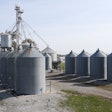
While studies have shown that grinding corn finer offers a higher feed efficiency for pigs, that isn’t necessarily the case with other feed ingredients. Joel DeRouchey, an animal science specialist from Kansas State University Research and Extension, talked about feed efficiencies on June 5 at the World Pork Expo in Des Moines, Iowa.
“We recognize as we grind corn finer, pigs are going be able to have better feed efficiency and better average daily gain,” said DeRouchey. “They can utilize more calories out of that feed when we grind it finer.”
For every 100 micron difference, feed efficiency with corn will improve about 1.2 percent and save the pig producer about $1 per head, he said.
DeRouchey acknowledged, however, that very few pig producers feed a diet consisting completely of corn. But does the same principle of finer feed lead to better efficiencies when it comes to other feed ingredients? DeRouchey said a recent study shows it does not.
In a mixed diet, grinding the feed can still improve feed efficiencies if there is a high enough corn content. However, for ingredients like distillers dried grains with solubles, soy meal, soy hulls or wheat mids, there is no evidence of improvement, and in some cases it even harms the overall feed efficiency.
“We have not in one case been able to find one growth benefit in grinding those ingredients compared to when they come into the mill in their normal form,” DeRouchey said. “When we reground soybean hulls, performance actually got worse because we made a whole bunch of fiber more available to tie everything up. It actually decreases digestibility more.”

















